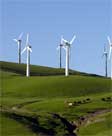
Together those two states, with just 3.5 of the nation’s population, have accounted for more than 24 percent of all new renewable power in the United States this year. And that doesn’t include hydro.
The lesson here is not that the Northwest is super-duper special, but that this kind of clean power surge can happen anywhere. Neither state is uncommonly well-suited for new renewable projects. We’re famous for our lack of sun, so solar’s not a great option. Parts of the region are windy, but plenty of other places are windier.
What Oregon and Washington do have going for them is the foresight to make smart investments. So I say: both states should get credit for aggressively pursuing an array of technologies and solutions. It’s also a case where virtue is its own reward: a robust clean power portfolio makes it easy for the Northwest to adapt to new policies that will crimp greenhouse gases.
The more early action like this, the smoother the transition to a carbon-constrained economy. As a result of these investments the Northwest will be better-positioned to succeed in that era than many other places.
More details below the jump.
Here’s how it breaks down. Comparing the first half of 2007 to the first half of 2006, renewable power (again, not counting hydro) has spiked by 4.3 gigawatt hours in Washington and almost 1.9 in Oregon. The region’s clean energy burst is mostly due to some large scale investments in wind generation. But, again, loads of other places in North America are as well suited for wind energy.
Technically, “other renewable” power—that’s the category that the data refer to—means “wood, black liquor, other wood waste, municipal solid waste, landfill gas, sludge waste, tires, agriculture byproducts, other biomass, geothermal, solar thermal, photovoltaic energy and wind.” It’s that last one that’s really kicked into gear in Oregon and Washington.
By the way, I should also give props to California, which accounted for another 25 percent of the nation’s total increase in renewable power. That means half of the nation’s new clean power came from the West Coast.
Finally, tip o’ the hat to frequent commenter, Matt the Engineer, who alerted us to the data.








MichelleV.P.
Awesome! Good news is always so wonderfully encouraging!Make that a huge hat tip to Matt the Engineer, Eric and Sightline for the great write-up, and all States involved in this forward progress!
Matt the Engineer
I’d like to know where the rest of the media is on this story. It would be front page news if we were #1 for most anything else: housing prices, job growth, the design of our quarter…
Matt the Engineer
Uh oh. The same data has somebad news for WA and OR. Electricity from coal plants went from 2 and 1 GWh to 617 and 411 respectively. It looks like hydro and nuclear power went way down in the past year. Could the hydro be salmon related? Or maybe just a change in snowfall (’06 did have a lot of snow).